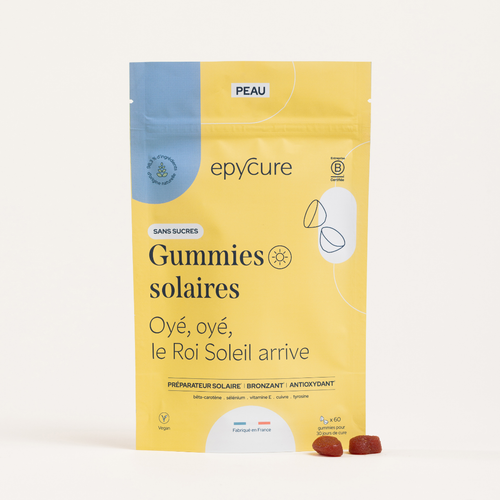As the sunny days approach, a tan and golden skin become essential for many of us. We love being able to spend hours basking in the sun. A pleasure that is both energizing and soothing and makes us feel good. But we too often forget that exposure to the sun presents many risks...
Tanning, what is it?
Tanning is the body's natural defense against the sun's ultraviolet (UV) rays . It comes from melanin , a dark pigment produced naturally by melanocytes when exposed to UV rays. In addition to absorbing these rays and therefore protecting our skin from solar radiation, melanin causes the appearance of a tan. Melanin activation occurs naturally within 2 or 3 days , regardless of the intensity of exposure. The more regularly we are exposed to the sun, the more melanocytes will be able to produce melanin and therefore contribute to tanning the skin.
What do we mean by 'sun capital'?
If dark skin is naturally better protected by the greater quantity of melanin in their epidermis, light skin not only does not tan but is more sensitive to the sun . To understand these differences, you need to know that there are 2 types of melanin. Phaeomelanin, produced by brown people, which protects the skin well from the sun and eumelanin, produced most often by red-haired people with fair skin, which is ineffective and does not protect against UV rays.
Each of us has a sun capital, determined genetically at birth , which depends on each person's phototype. The sun capital actually refers to the amount of UV rays tolerated by the skin before suffering skin damage . It is often compared to a tank that is pumped into with each exposure. It is non-renewable and helps fight against a specific quantity of UV rays throughout life. Once this capital is exhausted, the skin can no longer protect itself against the attacks of the sun... It is technically impossible for us to know our sun capital but we can however interpret certain signals which show that we have exposed ourselves too much: brown spots where the skin is thin, white spots following a burn, development of melanoma…
There is no miracle method for increasing your sun exposure and your skin's ability to tan. We must therefore remain vigilant and adopt the right reflexes from a young age to continue to enjoy the sun in complete safety! Indeed, it is from the beginning of life that we must be careful about excess sun because the defense system against UV attacks is not yet complete. To find out everything about UV rays and how to protect yourself from them, we share our advice with you in this article.
What are the benefits of the sun on our body?
Regularly singled out for its harmful effects on the skin and its involvement in the occurrence of cancer, the sun can also be beneficial (this is obviously not an excuse to overuse the sun and no longer follow the precautions given by health organizations. health ;)). It helps in particular with the synthesis of vitamin D , essential for the functioning of the body and for bone and muscle health ; it boosts immunity by activating the main immune cells; it maintains morale by stimulating the production of serotonin and endorphin and finally it intervenes in the improvement of the symptoms of certain skin diseases such as psoriasis or vitiligo thanks to its anti-inflammatory effect .
What are the risks of the sun on our skin?
But we also know that exposure to the sun presents many risks... So we take stock of these main risks which make sun exposure much less pleasant.
The sun burns
Tanning is a defense reaction to solar attack which has not exceeded a threshold limit. Beyond this threshold, sunburn occurs, an inflammatory reaction of the skin which appears after prolonged sunbathing . The action of UVB on the surface of the skin causes redness, pain and sometimes even itching and blisters.
Premature aging of the skin
The more we expose ourselves, the more we risk accelerating skin aging. Indeed, UVA rays are dangerous because they arrive in large numbers and penetrate the skin deeply. They cause the formation of numerous free radicals capable of damaging the collagen and elastin fibers of the skin . This is how the skin gradually loses firmness and wrinkles appear due to the sun.
Pigment spots
THE Pigmented spots found on the face and body are caused by too much exposure to the sun and show that the skin has had to defend itself against too much sun. Indeed, overexposure will lead to an imbalance of melanocytes, the cells that produce melanin, and therefore an overproduction of melanin . This is how these localized hyperpigmentation spots .
Summer lucite
Summer light is a common sun allergy , especially in women, caused by UVA which can affect the décolleté, shoulders, neck, arms, legs. It manifests itself between 1 to 3 days after the start of exposure to the sun , with a skin rash of small pimples and itchy red patches, enough to spoil the pleasure of basking in the sun.
Sunstroke
Sunstroke occurs following long exposure of the head to the sun . In fact, the sun locally heats the brain, which struggles to redistribute heat and maintain a body temperature that allows it to function properly. It most often manifests itself with intense headaches , significant fatigue, nausea and vomiting , and can lead to loss of consciousness.
Melanomas and cancers
We know with certainty that prolonged exposure to the sun is responsible for the development of skin cancer. Indeed, by hitting pigment cells, UVA can damage DNA and cause mutations . This is how melanomas appear, these malignant tumors of the skin's pigment system (melanocytes). In most cases, they take the form of a dark or black pigmented spot or develop through degeneration of an existing mole.
Note that nearly 80,000 new cases of skin cancer are diagnosed each year , according to the latest figures from the National Cancer Institute, including 65,000 carcinomas and more than 11,000 melanomas, the most serious cancer, a consequence of intense exposure to the sun during short periods of the year.
Sun gummies: the essential treatment to prepare and protect your skin in the sun
To avoid arriving as white as an aspirin pill on the first day of vacation, but also to help you protect your skin and prepare your tan from the inside out, turn to our sugar-free Sun Gummies , these little gummies with chew with a delicious cherry flavor!
This gummies treatment will help you enhance your tan while limiting skin aging , thanks to its complete formula:
-
Beta-carotene , a natural orange-colored pigment, gives a pretty golden, tanned tint to the skin, ensuring an immediate healthy glow. Furthermore, once absorbed, it will transform into vitamin A, giving it antioxidant properties, thus limiting the aging of the skin.
-
Tyrosine triggers the production of melanin, this molecule which protects the skin from the harmful effects of the sun and allows the skin to tan.
-
Selenium and vitamin E are antioxidants that help protect skin cells against oxidative stress, induced by UV rays and responsible for skin aging.
-
Vitamin C strengthens the skin and promotes healing by stimulating collagen synthesis, which helps delay sunburn.
As a 2 to 3 month treatment and combined with your usual sunscreen, they will work miracles this summer!
To find out everything about tanning and our tips to apply this summer, download our tanning booklet by clicking right here .



